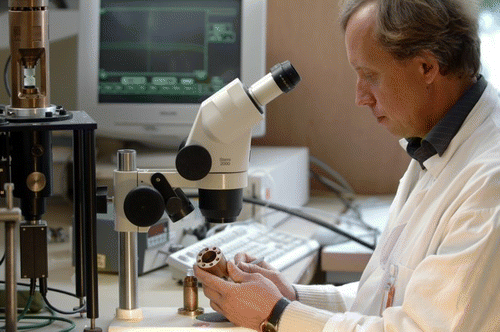
Igor Goncharenko was born in Novosibirsk (USSR) on 2 June 1965. He disappeared in a scuba diving accident in the Red Sea, near to Hurghada (Egypt), on 4 November 2007. After completing high school in Novosibirsk, Igor went to Moscow in 1982 and started engineering studies. He graduated in Advanced Studies at the Institute of Physics and Technology in Moscow in 1988. He prepared his thesis on the ‘crystal structure and equation of state of hydrides under pressure’ during the years 1988–1991, and then became an associate researcher at the Russian Scientific Centre ‘Kurchatov Institute’ of Moscow. When Igor started his Ph.D. work, the Kurchatov Institute had already a high expertise in high-pressure neutron diffraction, developing diamond anvil cells adapted to neutron beams. The main limitation of those devices was the very small sample size, which restricted the neutron studies to samples with high-scattering cross-sections. During the years 1986–1990, Igor developed new sapphire-anvil pressure cells, reaching 7–8 GPa with larger sample volumes. This technique, published in 1988, was successfully used later on at several neutron centers in Russia, France and Japan.
Igor started to collaborate with the Laboratoire Léon Brillouin (LLB, Saclay, France) in 1991, when an agreement was signed between Jean Rossat-Mignod (LLB) and Victor Somenkov (KI), to combine the Russian expertise in high pressures with the potential of a high-luminosity neutron source. For several years, Igor spent about half of his time in France and LLB through temporary contracts before obtaining a position at the Centre National de la Recherche Scientifique (CNRS), the main French research organization in 1995. He obtained his second degree of the Doctorate in Physics (the highest scientific diploma in Russia, which gives the right to direct scientific studies) in 1999.
High-pressure diffraction requires very small samples, down to 0.0001 mm3, and therefore much smaller than the samples usually measured in neutron experiments. While at LLB, Igor developed a specific spectrometer, dedicated to high-pressure neutron powder diffraction, by implementing focusing devices with supermirrors on a diffractometer already equipped with a multidetector, and installed on a cold neutron source. These devices increased the neutron flux by one order of magnitude. A specific shielding was also implemented to reduce the background. These achievements allowed him to perform neutron experiments under pressures up to 51 GPa, a world record established in 1997 which still holds today. Igor also developed specialized high-pressure cells, available for single crystals and powders, which could be combined with very low temperatures (down to 50 mK) and high magnetic fields (up to 7 T). In the last few years, he designed a hybrid high-pressure cell, which he used both for X-rays and neutrons, in combined pioneering experiments performed both at the synchrotron source of the ESRF and at the LLB.
Building on these technical achievements, Igor performed numerous pioneering studies of crystal and magnetic structures under high pressures, bringing answers to long-standing questions in solid-state physics. He directed, or co-directed, several Ph.D. works on these subjects. In the field of magnetism, he studied model ferromagnetic and antiferromagnetic Heisenberg systems like EuS, EuSe or MnO, as well as heavy-fermion and mixed-valence compounds. He also investigated frustrated magnets, like the Laves phases and their hydrides, which show a transition from localized to itinerant magnetism, tuned by pressure. In the geometrically frustrated pyrochlores called ‘spin liquids’, ‘spin ices’ or ‘spin glasses’, he discovered novel types of orders under pressure. He determined high-pressure magnetic structures in solid oxygen and the nature of its mysterious epsilon phase, a precursor to superconductivity. His contribution to crystal structures was also of great significance, with the recent determination of the broken-symmetry phase of solid deuterium, using both neutron and X-ray diffraction, and the structure of a pressure-induced hydrogen-dominant metallic state in an aluminum hydride under extreme pressure, in the megabar range.
The work of Igor Goncharenko was widely recognized and appreciated among the international community, both in neutron and high-pressure science. This is shown by the numerous invited talks he presented in the last few years, as well as by his many articles in top-level journals (two letters in Nature and a dozen letters in Physical Review Letters, Europhysics Letters and the Physical Review, among others). In 1996, Igor was elected a member of the High-Pressure Commission of the International Union of Crystallography, and re-elected in 1999. He also took part in the organization of the scientific programs of several International Conferences, in France, Russia, United States, Japan or Great Britain.
Only a few people knew that Igor was not just a great scientist, but also a passionate scuba diver. Actually, he loved sports challenges almost as much as scientific ones. Over the years, he acquired professional skills and, when he disappeared in the Red Sea, he was approaching the amazing depth of 200 m (the 1999 world record).
Igor was an outstanding experimentalist, and a researcher with rare tenacity and tremendous working power. When working with him, scientific miracles started to seem natural. He always applied great care to all his activities, whether scientific, technical or sporting, but never took himself too seriously. Everyone remembers his simplicity and sense of humor. His death was a terrible shock for his wife Lada, his parents Nina and Nicolai and family, and a big loss for his friends and colleagues and for the scientific community as a whole. He will be missed by all of us.